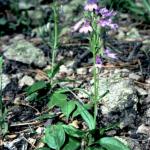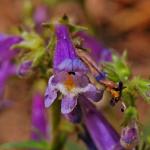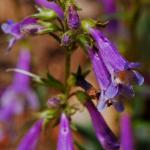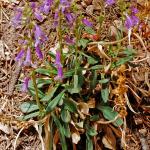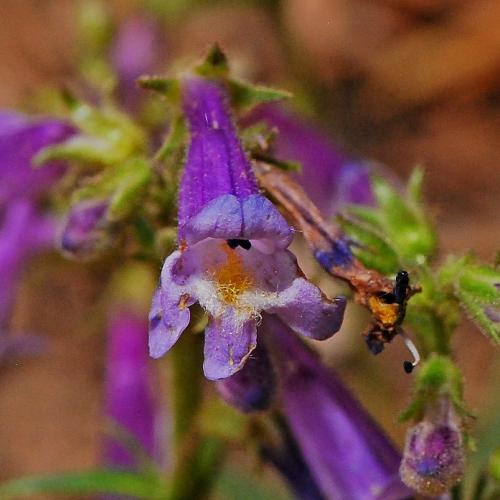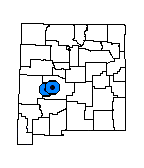Penstemon pseudoparvus (San Mateo Penstemon)
Penstemon oliganthus Wooton & Standley
Compact herbaceous perennial from a woody rhizome; stems 1-5, 10-30(32) cm high, 1.0-2.3 mm in diameter at the base, finely puberulent; leaves moderately thick, opaque, minutely puberulent and soon glabrescent or puberulent merely on the midvein, faintly glaucescent; basal leaves petiolate, 5-18 mm wide, 15-50 mm long, spatulate to broadly elliptic, entire, usually forming a basal rosette persistent at anthesis; stem leaves sessile, entire, usually somewhat revolute, the lowest narrowly lanceolate, becoming linear and more noticeably puberulent and slightly glandular toward the inflorescence, 0.8-5.0 mm wide, 18-42 mm long; inflorescence a virgate, somewhat secund, verticillate thyrse of opposing cymules (often only one of a pair developed), evidently glandular, 3-10 flowers, lower bracts puberulent and glandular, 0.8-5.0 mm wide, 9-34 mm long, reduced to about 2 mm long toward the top of the inflorescence, peduncles about half as thick as the main rachis, somewhat longer than the ultimate pedicels, cymules ascending, bracteoles minute; calyx green, tinged with purple, 1.5-2.0 mm wide, 3.5-5.0 mm long, lobes lance-ovate and slightly scarious-margined, glandular; corollas mostly ascending, rarely horizontal but never drooping, (11)12-17 mm long, 3-6 mm wide at the orifice, externally moderately glandular, gradually but little expanded and not inflated, pale lavender at base deepening to blue-purple at the lobes, lobes extending along the axis of the tube or hardly spreading, the anterior hardly exceeding the posterior, the throat open, the lower lip bearded with moderately long white hairs, the floor glabrous and obscurely ridged; anther sacs opposite after dehiscence, opening almost throughout, not explanate, longer than wide, not dentate along the suture; staminode not enlarged distally, usually included, densely pectinate-bearded its length with stiff golden hairs. Flowers July and August.
No similar species occur in the San Mateo Mountains. The most similar allopatric species is Penstemon oliganthus, which is distinguished by obscurely puberulent stems and horizontal or drooping flowers. Penstemon inflatus has a decidedly inflated corolla tube and P. metcalfei has glabrous stems and larger stem leaves and bracts.
New Mexico, Socorro County, Magdalena and northern San Mateo mountains.
Open ponderosa pine or spruce-fir forests and high montane meadows; 2,700-3,050 m (9,000-10,000 ft).
This plant is not easily distinguishable from Penstemon oliganthus and may eventually be treated as a variation of that species. Put into synonymy with P. oliganthus (FNA Vol 17, 2019), which is widespread in NM, also in AZ and CO.
The effects of grazing and forest fire on this plant have not been studied.
*Heflin, J. 1997. Penstemons: The beautiful beardtongues of New Mexico. Jackrabbit Press, Albuquerque, New Mexico.
*Crosswhite, F.S. 1965. Revision of Penstemon section Penstemon (Scophulariaceae)II: A western alliance in series Graciles. American Midland Naturalist 74:429-442.
For distribution maps and more information, visit Natural Heritage New Mexico

